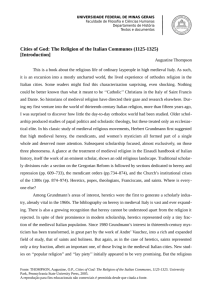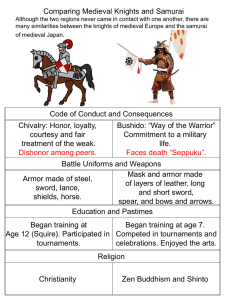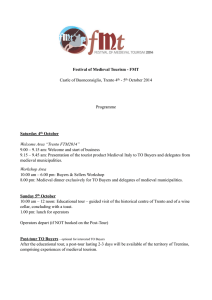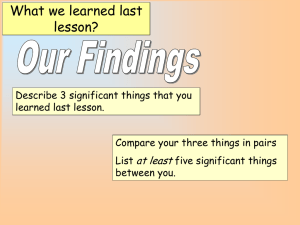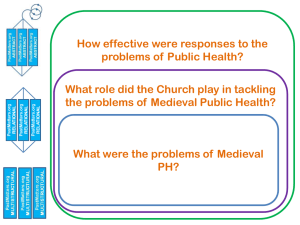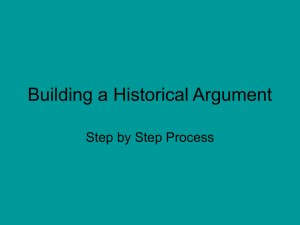HIST 450, SECTION 03 – VIKING SOCIETIES AND CULTURE
advertisement
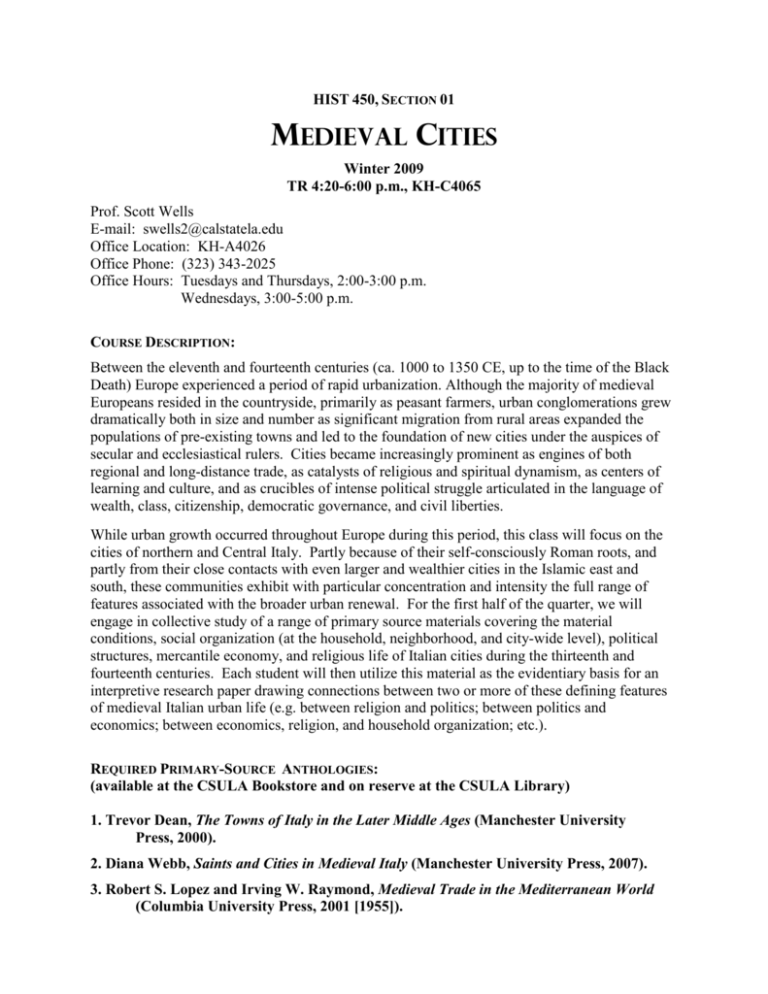
HIST 450, SECTION 01 MEDIEVAL CITIES Winter 2009 TR 4:20-6:00 p.m., KH-C4065 Prof. Scott Wells E-mail: swells2@calstatela.edu Office Location: KH-A4026 Office Phone: (323) 343-2025 Office Hours: Tuesdays and Thursdays, 2:00-3:00 p.m. Wednesdays, 3:00-5:00 p.m. COURSE DESCRIPTION: Between the eleventh and fourteenth centuries (ca. 1000 to 1350 CE, up to the time of the Black Death) Europe experienced a period of rapid urbanization. Although the majority of medieval Europeans resided in the countryside, primarily as peasant farmers, urban conglomerations grew dramatically both in size and number as significant migration from rural areas expanded the populations of pre-existing towns and led to the foundation of new cities under the auspices of secular and ecclesiastical rulers. Cities became increasingly prominent as engines of both regional and long-distance trade, as catalysts of religious and spiritual dynamism, as centers of learning and culture, and as crucibles of intense political struggle articulated in the language of wealth, class, citizenship, democratic governance, and civil liberties. While urban growth occurred throughout Europe during this period, this class will focus on the cities of northern and Central Italy. Partly because of their self-consciously Roman roots, and partly from their close contacts with even larger and wealthier cities in the Islamic east and south, these communities exhibit with particular concentration and intensity the full range of features associated with the broader urban renewal. For the first half of the quarter, we will engage in collective study of a range of primary source materials covering the material conditions, social organization (at the household, neighborhood, and city-wide level), political structures, mercantile economy, and religious life of Italian cities during the thirteenth and fourteenth centuries. Each student will then utilize this material as the evidentiary basis for an interpretive research paper drawing connections between two or more of these defining features of medieval Italian urban life (e.g. between religion and politics; between politics and economics; between economics, religion, and household organization; etc.). REQUIRED PRIMARY-SOURCE ANTHOLOGIES: (available at the CSULA Bookstore and on reserve at the CSULA Library) 1. Trevor Dean, The Towns of Italy in the Later Middle Ages (Manchester University Press, 2000). 2. Diana Webb, Saints and Cities in Medieval Italy (Manchester University Press, 2007). 3. Robert S. Lopez and Irving W. Raymond, Medieval Trade in the Mediterranean World (Columbia University Press, 2001 [1955]). ASSIGNMENTS AND GRADING: Class Participation: 30% of course grade For each class meeting, complete the assigned readings in advance and bring your notes and questions. Participation will include active engagement in class discussions, the periodic submission of your reading notes, occasional in-class reaction papers, and a final oral presentation on your research topic to be delivered on March 10 or 12. Annotated Bibliography: 10% of course grade Compile a bibliography of approximately twelve to fourteen scholarly articles and books whose analysis of the material, social, economic, political, and religious conditions of medieval Italian urban life you will be able to incorporate into the historiographic section(s) of your final paper. For each item, provide a brief description (ca. 100 words) summarizing its main argument and evaluating its contents. Annotated bibliographies are due at the start of class on February 24. Annotated bibliographies handed in late will be penalized with a 10% reduction in grade. Final Paper: 60% of course grade The major assignment for this course is a research paper fifteen to twenty pages in length illuminating Italian city life during the thirteenth and fourteenth centuries by analyzing the interconnectedness of at least two or three distinct features of the urban experience as outlined over the first five weeks of the class. The final paper should incorporate extensive evidence from the primary sources discussed in class, supplemented by an analysis of related arguments drawn from the scholarly works incorporated into your annotated bibliography. An outline of the final paper is due at the start of class on Tuesday, March 3. The hard copy of your final paper must be delivered to the instructor no later than 6:00 p.m. on Thursday, March 19. Final Papers handed in late will automatically be penalized with a 10% reduction in grade. Academic Honesty As with all your courses at Cal State L.A., you are required to adhere to the University's policy on academic honesty, which can be found at the following website: http://www.calstatela.edu/univ/stuaffrs/Academic_Honesty.htm COURSE SYLLABUS 1/6 Introduction: ‘Urbanization’ in a Medieval Context 1/8 The Material Environment of Medieval Italian Cities Discussion of the materials in: Trevor Dean, The Towns of Italy, pp. 5-62. 1/13 Urban Christianity: Charity, Mysticism, and Heresy Discussion of the materials in: Trevor Dean, The Towns of Italy, pp. 63-108. 1/15 The Urban Economy: Trade, Manufacture, and Guilds Discussion of the materials in: Trevor Dean, The Towns of Italy, pp. 109-140. 1/20 Urban Social Structures: Classes, Neighborhoods, Households Discussion of the materials in: Trevor Dean, The Towns of Italy, pp. 141-212. 1/22 Political Organization and Experimentation in the Italian City-States Discussion of the materials in: Trevor Dean, The Towns of Italy, pp. 213-244. 1/27 Saints’ Lives as Sources for Social, Political, and Economic History Discussion of the vitae of Raimondo Palmario, Umiliana de’ Cerchi, and Andrea Gallerani as translated in: Diana Webb, Saints in Medieval Italy, pp. 62-159. 1/29 Saints’ Lives as Sources for Cultural and Religious History Discussion of the vitae of Zita of Lucca and Pier Pettinaio as translated in: Diana Webb, Saints in Medieval Italy, pp. 160-241. 2/3 Medieval Italian Cities in a Mediterranean and ‘Global’ Context Discussion of selected materials from: Robert Lopez and Irving Raymond, Medieval Trade in the Mediterranean World, pp. 51-235. 2/5 How to Network in the Medieval Urban Economic and Social Environment Discussion of selected materials from: Robert Lopez and Irving Raymond, Medieval Trade in the Mediterranean World, pp. 239-426. 2/10 Discussion of Paper Topics Write and bring to class a short paragraph (ca. 200-300 words) describing the interrelated aspects of Italian urban life you would like to analyze in your final paper. 2/12 Utilizing Secondary Sources Write and bring to class a brief (ca. 100 word) description of the argument and contents of one of the articles you are planning to include in your annotated bibliography. 2/17 Defining Historiographic Context in Your Papers Write and bring to class a brief (ca. 100 word) description of the argument and contents of another one of the articles you are planning to include in your annotated bibliography. 2/19 No Class Meeting I will be available for consultation at our seminar room, KH C4065 2/24 Submission of Annotated Bibliographies In class, we will discuss the format and content requirements for paper outlines. 2/26 No Class Meeting I will be available for consultation at our seminar room, KH C4065 3/3 Submission of Paper Outlines In class, we will also discuss the format for project presentations. 3/5 Discussion/Evaluation of Paper Outlines 3/10 Oral Presentations on Paper Projects 3/12 Oral Presentations on Paper Projects 3/19 Final Paper Due by 6:00 p.m. in Prof. Wells' Office



